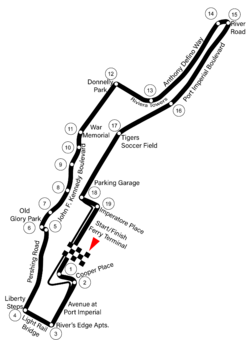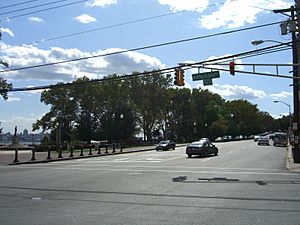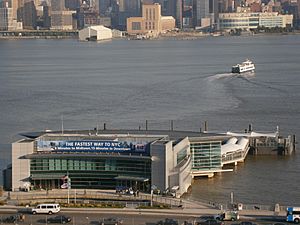Port Imperial Street Circuit facts for kids
 |
|
| Location | Weehawken and West New York, New Jersey |
|---|---|
| Time zone | UTC-5 |
| Coordinates | 40°46′37″N 74°00′40″W / 40.776853°N 74.011120°W |
| Architect | Hermann Tilke |
| Length | 3.20 mi (5.15 km) |
| Turns | 19 |
The Port Imperial Street Circuit was a plan for a cool race track in Weehawken and West New York, New Jersey. This track, planned in 2011, would have been about 3.2 miles (5.15 km) long. It was designed to be built right on the Hudson Waterfront in New Jersey, near a place called Weehawken Port Imperial.
Contents
History of the Race Track Plan
Why the Grand Prix of America Didn't Happen
The idea for the Port Imperial Street Circuit was first shared in October 2011. The plan was to host a big car race called the Grand Prix of America. This race would have been part of the Formula One World Championship, which is run by the FIA.
The race was supposed to start in 2013. However, it faced many delays and was put off several times. There were problems with money, and the FIA didn't give its final approval. The people organizing the race also weren't fully ready. There were also disagreements about the agreements made.
When the 2013 race was removed from the schedule, the head of Formula One, Bernie Ecclestone, said the organizers had not kept their promises. He mentioned that new groups could offer to host the race instead. The Port Imperial race was added and then removed from future Formula One plans many times. By 2016, it was completely taken off any future schedules.
Circuit Location and Design
Where the Track Would Have Been Built
Finding the right spot for the circuit took several years. The chosen location in the New York Metropolitan Area was special. It was close to the Hudson River and the Hudson Palisades. This spot offered amazing views of the city skyline. It also had natural hills and was easy to reach by public transport.
How the Track Was Designed
A German track designer named Hermann Tilke created the circuit's layout. The cars would have raced in a clockwise direction. The starting line was planned near the NY Waterway ferry terminal. The pit stops and team areas would have been between the ferry terminal and Port Imperial Boulevard.
The first part of the track would have followed the Hudson River Waterfront Walkway. Cars would race through Port Imperial. Then, they would climb up the Hudson Palisades along Pershing Road. The track would then go north on Boulevard East to Donnelly Memorial Park. From there, it would turn right and go down Anthony M. DeFino Way. This would lead to a sharp hairpin turn near a water treatment plant. Finally, the circuit would return south to the ferry terminal using Port Imperial Boulevard.
The track would have had a big change in height, about 150 feet (46 meters). This would have made it one of the most exciting tracks for drivers. Even though the track passed through neighborhoods, people living there would still have access to their homes. The organizers planned to pay for the race without using any public money.
Promotional Runs on the Proposed Track
Drivers Test the Route
In June 2012, famous race car driver Sebastian Vettel drove a part of the planned route. He said the track was "exceptional" and would become a favorite for drivers. He noted that the hills and turns reminded him of other famous tracks like Circuit de Spa-Francorchamps and Circuit de Monaco.
Vettel believed the circuit would have "quick, floating corners." He expected cars to reach speeds over 200 mph (320 km/h). He thought the track would reward the bravest drivers.
In August 2012, another driver, David Coulthard, also drove parts of the course. He was testing the roads for a video promoting Red Bull Racing.
Planning for Construction
Preparing the Roads and Facilities
In June 2013, the race organizer, Leo Hindery, announced that all local permits were approved. He said 31 companies were getting ready to work on the track. The circuit would use existing roads, so no new sections needed to be built just for the race. Only the pit lane would be new. The towns and race promoters signed a contract in June 2013. That same month, a new bridge opened. This bridge connected a building to the Port Imperial Hudson–Bergen Light Rail station. This was important for people to get to the race.
Work on a parking garage at the NY Waterway ferry terminal started in July 2012. This garage was meant to be the race headquarters and team area. It would have space for twenty-four pit garages. Normally, the ground floor of this building would have shops. But each year, it would be changed for the race. The garage was finished in the summer of 2013. In November 2013, construction began on two hotels above the parking garage.
Plans were made to repave the roads for the race from August to November 2013. The repaving would be done carefully to create a very smooth surface. It was also considered that barriers from the old Valencia Street Circuit could be used for this track.
See also
 In Spanish: Circuito callejero de Port Imperial para niños
In Spanish: Circuito callejero de Port Imperial para niños



